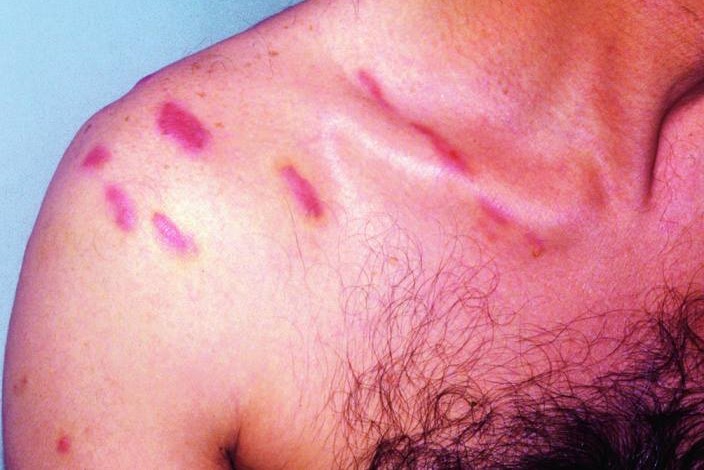
Kaposi's sarcoma: discover what it is
Kaposi’s sarcoma is a multicentric vascular tumour caused by herpes virus type 8. The various forms are classical, AIDS-associated, endemic (in Africa), or iatrogenic (e.g. after organ transplantation)
Diagnosis is made by biopsy.
Treatment of asymptomatic superficial lesions includes cryotherapy, diathermocoagulation or electron radiotherapy.
Radiation therapy is used in more extensive disease.
In AIDS-associated forms, antiretroviral drugs give the best result.
Kaposi’s sarcoma arises from endothelial cells in response to infection with human herpes virus type 8 (HHV8)
Immunodepression (particularly from AIDS and drugs in organ transplant recipients) greatly increases the likelihood of sarcoma development in patients with human herpes virus type 8 infection.
Tumour cells are fusiform and resemble smooth muscle cells, fibroblasts and myofibroblasts.
Classification of Kaposi’s sarcoma
Sarcoma in the classical form
This form most often appears in elderly men (> 60 years) of Italian, Jewish or Eastern European origin.
The course is asymptomatic and usually the disease is limited to a few skin lesions of the lower extremities; visceral involvement occurs in < 10% of cases. It is generally non-lethal.
Classical Kaposi’s sarcoma:
This sarcoma is a vascular tumour caused by human herpes virus type 8 infection.
The classic form of sarcoma occurs most often in elderly men, is indolent, and is usually limited to a small number of lesions on the skin of the lower limbs.
The skin lesions appear as asymptomatic purplish, pinkish or red macules that may develop into blue-violet to black plaques and nodules.
AIDS-associated Kaposi’s sarcoma (epidemic Kaposi’s sarcoma)
This form is the most frequent AIDS-associated tumour and is more aggressive than classical sarcoma.
Multiple lesions are usually present, often involving the face and trunk.
Mucosal, lymphatic and gastrointestinal involvement is frequent.
Sometimes this sarcoma is the first manifestation of AIDS.
Sarcoma in the endemic form
This form occurs in Africa independently of HIV infection.
There are 2 main types:
- The prepubertal lymphadenopathic form: this mainly affects children; the primary tumours involve the lymph nodes, with or without skin lesions. Generally, the course is fulminant and fatal.
- Adult form: this form is similar to classical Kaposi’s sarcoma.
Iatrogenic Kaposi’s sarcoma (immunosuppressive sarcoma)
This form typically develops many years after an organ transplant.
The course is more or less rapid, depending on the degree of immunodepression.
Symptomatology of Kaposi’s sarcoma
The skin lesions appear as asymptomatic purplish, pinkish or red macules which may develop into blue-violet to black plaques and nodules.
Some degree of oedema may be present.
Occasionally, nodules are fungiform or infiltrate soft tissue and invade bone.
Although less frequent, visceral involvement most often involves the oral cavity, gastrointestinal tract and lungs.
Symptoms depend on the involvement of specific organs.
Mucosal lesions appear as bluish-purple macules, plaques and nodules.
Gastrointestinal lesions may sometimes bleed profusely although they are usually asymptomatic.
Diagnosis of sarcoma
Biopsy
The diagnosis of this sarcoma is confirmed by biopsy with a cylinder scalpel.
Patients with AIDS or the immunosuppressed should be evaluated for possible visceral spread by chest-abdomen CT scan.
In the presence of respiratory or gastrointestinal symptoms even with a negative CT scan, bronchoscopy or digestive endoscopy should be considered.
Treatment of Kaposi’s sarcoma
- surgical excision, cryotherapy, electrocoagulation, intralesional chemotherapy, or possibly topical imiquimod for superficial lesions
- Local radiotherapy and chemotherapy for multiple lesions, diffuse involvement or lymph node disease
- Antiretroviral therapy with similar local treatments or chemotherapy according to the extent of the disease in case of AIDS-associated Kaposi’s sarcoma
- Reduction of immunosuppressants for iatrogenic Kaposi’s sarcoma
Treatments for classical and AIDS-associated sarcoma overlap considerably.
Asymptomatic lesions often do not require treatment.
One or more superficial lesions may be removed by resection, cryotherapy or electrocoagulation or treated with intralesional vinblastine or interferon alpha.
Topical imiquimod has been reported to be effective.
Multiple lesions, diffuse involvement and lymph node disease are treated locally by radiation therapy at doses of 10-20 Gy and chemotherapy.
Recurrence is frequent and complete cure is difficult to achieve.
AIDS-associated sarcoma responds readily to highly active antiretroviral therapy, probably because the CD4+ count improves and the HIV viral load decreases; however, there is some evidence that protease inhibitors in this regimen may prevent angiogenesis.
In AIDS patients with localised asymptomatic disease who have CD4+ > 150/mcL and HIV RNA < 500 copies/mL, intralesional vinblastine may be added.
Pomalidomide may also be used for more indolent lesions. Patients with more extensive disease or visceral disease may take pegylated liposomal doxorubicin 20 mg/m2 EV every 2-3 weeks.
Paclitaxel is an alternative first-line treatment or may be given if pegylated liposomal doxorubicin fails.
Other agents investigated as adjuvants include interleukin-12, deoxyferrioxamine and oral retinoids.
Treatment of Kaposi’s sarcoma does not improve life expectancy in most AIDS patients, as infectious events dominate the clinical course.
Iatrogenic Kaposi’s sarcoma responds best with discontinuation of immunosuppressive therapy.
In transplanted patients, dose reduction of immunosuppressive drugs often results in a reduction of Kaposi’s sarcoma lesions.
If dose reduction is not possible, conventional local and systemic therapies used in other forms of Kaposi’s sarcoma should be undertaken.
Sirolimus may also improve iatrogenic Kaposi’s sarcoma.
Treatment for endemic Kaposi’s sarcoma is challenging and typically palliative.
Read Also:
Emergency Live Even More…Live: Download The New Free App Of Your Newspaper For IOS And Android
Sanofi Pasteur Study Shows Efficacy Of Co-Administration Of Covid And Influenza Vaccines
WHO: ‘Pandemic Will Continue Unless Vaccines Are Distributed To Poor Countries’
Covid And HIV: ‘Monoclonal Antibodies For The Cures Of The Future’
HIV, MRNA Vaccine Study By Iavi And Moderna


